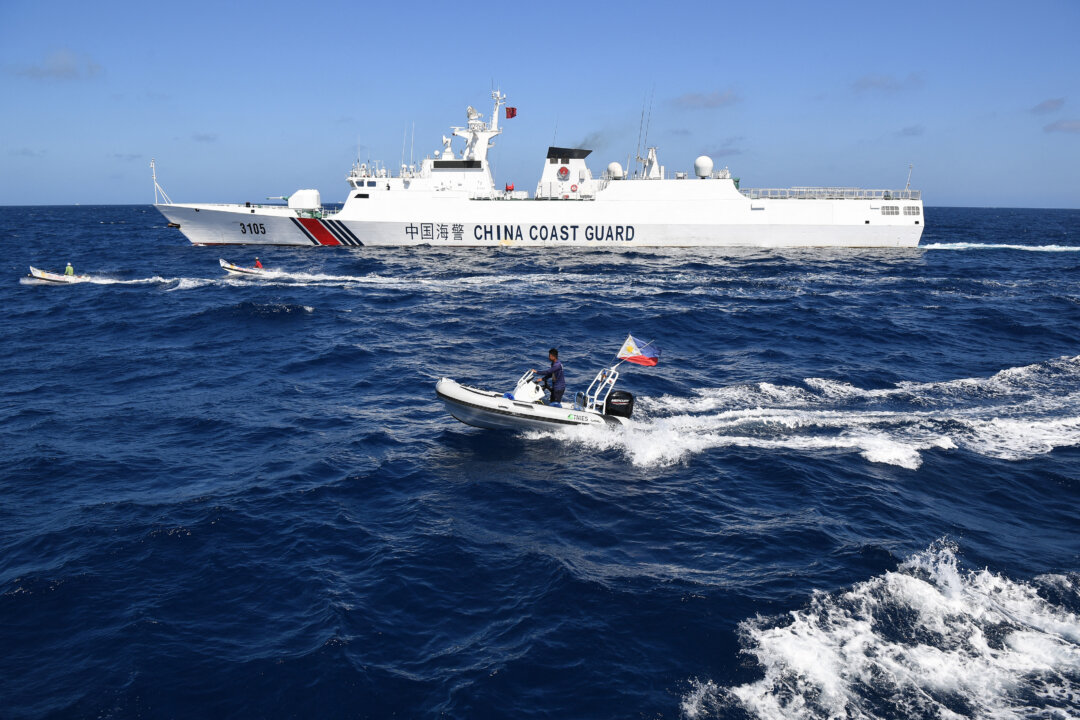Philippines National Maritime Council (NMC) spokesman retired Vice Adm. Alexander Lopez said on Tuesday that the Philippines may file another diplomatic protest with Beijing after Chinese coast guard vessels “rammed“ into a Philippine coast guard ship near the Escoda Shoal, while considering expanding its recent agreement with China in the area.
Tensions have been escalating between the Philippines and the Chinese Communist Party (CCP) in the South China Sea, with the collision incident occurring barely 10 days after Chinese Air Force planes dropped flares in the path of Philippine Air Force planes on patrol.
Philippine officials held a news briefing on Tuesday after releasing footage of the collision of the coast guard vessels on Monday.
Lopez said the actions of the Chinese military were “ridiculous.”
“There is a code of conduct among seafarers, the principle behind it is to ensure safety among vessels of the high seas,” he said during the question-and-answer portion of the televised conference. “But what happened is [the Chinese coast guard] went to [the] extreme of putting a vessel at risk. Coast guard ensure the safety of life and property at sea, and yet they are the ones doing it.”
He said the Philippines is committed to resolving the issue diplomatically and peacefully and may file another diplomatic protest after more information surfaces from the coast guard.
This follows a July 24 provisional agreement between Beijing and Manila to allow Philippine resupply missions for naval vessels at the Escoda Shoal without inspection from China. Philippine officials at the time said the parties had reached a common understanding to ease tensions and “prevent skirmishes.” The details of the agreement remain confidential.
The NMC said on Monday it was considering expanding that agreement with China to cover more of the Philippines’ exclusive economic zone (EEZ). According to international law, a coastal country can claim the 200 nautical miles from its shores as its EEZ, giving it jurisdiction over its resources and activities. The Escoda Shoal is an atoll of the Spratly Islands, about 75 nautical miles off the coast of Palawan, Philippines.
The Philippine coast guard had on Aug. 17 stated its legal right to be in the area after the CCP released a statement accusing the Philippines of infringing on its sovereignty. Two days later, the respective coast guards clashed.
Chinese coast guard spokesperson Gan Yu said in a statement released through China’s state-run Xinhua News Agency that the Philippine vessel had “ignored multiple warnings” and collided with the Chinese vessel in “an unprofessional, dangerous manner.” Gan accused the Philippine coast guard of trespassing and warned of “consequences.” Chinese media reported that the Philippine vessels had illegally used force in making their way to the area.
Meanwhile, Philippine officials accused the Chinese coast guard of “unlawful and aggressive maneuvers.”
The U.S. State Department condemned “dangerous actions” on the part of the Chinese military in the encounter.
The Chinese coast guard “employed reckless maneuvers, deliberately colliding with two Philippine Coast Guard ships, causing structural damage and jeopardizing the safety of the crew onboard,” the department said in a statement.
Chinese Foreign Ministry spokesperson Mao Ning said the Chinese military actions were “beyond reproach” and that the United States has “no right to intervene in maritime matters between China and the Philippines.”
The South China Sea is a key strategic zone for both the United States and China. About a third of the world’s trade—an estimated $3 trillion to $5 trillion—passes through this area, giving countries an interest in protecting international free waters. This year, 26 countries joined the Rim of the Pacific Exercise, the world’s largest naval drill, led by the United States.
Access to several waterways by southern Pacific islands is also critical if the United States or other countries have an interest in reaching Taiwan, which produces nearly all of the world’s most advanced chips.
The CCP has increased its presence in the South China Sea over the past three decades, with the aim of securing a military advantage over the United States, allowing it to easily seize Taiwan.

